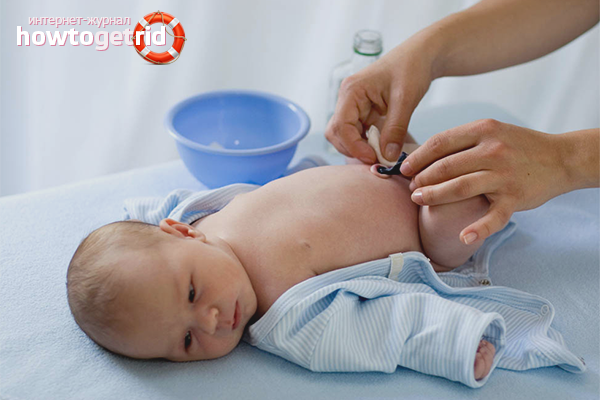The content of the article
After a difficult birth process, a lot of questions arise for mother, especially if the baby is the first. The measured pregnant everyday life turns into a marathon of feeding, changing diapers and swimming. Caring for a child, especially in the early days of his life, is the basis of his future health and immunity. One of the main issues in caring for a newborn is how to process his belly button. The umbilical cord that connected the baby and mother was the main source of nutrition, oxygen, and vitamins. After birth, the umbilical cord is cut, but until the open wound heals, this part of the body remains potentially dangerous. The fact is that an open, unhealed navel is the gateway to infection and germs. Therefore, you need to monitor the navel very carefully.
How to process a belly button
In the hospital after delivery, the cut umbilical cord is fixed with a special clothespin. A few days later she disappears. Usually this time coincides with the moment when the young mother is discharged home with the baby. Often, this particular criterion allows the baby and young mother to go home. However, the navel falls off in different ways for everyone, so some women have to wait until the navel falls off, a week, or more.
After separation of the dried part of the umbilical cord, the open umbilical wound remains in the designated place. In principle, it can heal on its own, in some countries in medicine there is no concept at all - to process the navel. However, we still try to protect our crumbs from possible infection and inflammation. Therefore, we will tell in detail about how, what, when, and how much to process the navel.
- Let's start with how often to do the processing procedure. You need to process the navel twice a day, not more often. Frequent anxiety of the damaged area prevents it from healing. Your task is to provide your beloved navel with dryness and cleanliness. Evening treatment is better after taking a bath.
- Before treating the baby’s navel, do not forget about the cleanliness of your own hands - wash them with antibacterial soap.
- The first thing we need is hydrogen peroxide and a pipette. Gently drop a few drops of the drug into the navel of the baby. The navel starts to foam - this is absolutely normal. After that, wait a few minutes for the dried blood and epithelium to soften. Carefully clean the navel of the newborn from unnecessary clots using a cotton swab to clean the ears. If your baby’s navel is in folds, climbing is deeply contraindicated. Treat only the upper part of the wound, do not try to crawl under the skin. This slows down the healing process of the wound.
- After the navel is cleaned of everything unnecessary, it is necessary to treat it with an antiseptic composition. Previously, this was done with the help of green. However, today this is not necessary. The fact is that zelenka creates a thin film on the skin that prevents the passage of air. In addition, the intense color of the green does not allow you to see the possible redness or swelling of the skin. Therefore, modern pediatricians recommend abandoning this kind of treatment.
- Instead of brilliant green, the baby's skin can be treated with a weak solution of potassium permanganate. It is not recommended to use alcohol - it dries the skin very much and delivers very painful sensations. Dissolve potassium permanganate in water so that a pinkish color is obtained. Strain the composition through several layers of gauze to prevent the smallest crystals of potassium permanganate from getting on the skin. After that, moisten a cotton pad in the solution and carefully treat the wound.
- Instead of peroxide, Chlorophyllipt 1% can also be used.This is an excellent antiseptic drug that fights not only with simple pathogens, but also staphylococcus. Often it is sold in the form of a spray, which facilitates its use.
- It is not worth closing the navel after processing - no plasters or bandages. For the wound to heal, it needs access to fresh air. After treatment, let the baby lie naked for some more time, you can use these moments for stroking and light massage of the child. It is not only pleasant, but also very useful.
- A few words need to be said about diapers. There are special diapers on sale that leave access to the navel open. If you did not find such diapers, just fold the top of the diaper so that the navel remains open, in no case cover the wound with an airtight material. Clothing should also only be cotton so that the wound is ventilated and the skin breathes.
These simple rules will help you to process your navel quickly and without fear.
How much the navel heals
Usually the umbilical cord falls off 3-5 days after birth. Then, within a few more weeks, the wound heals like normal skin damage. At first, the navel can bleed - this is absolutely normal, you should not be afraid of this. Usually, by the first month of the child’s life, the navel heals completely and there is no trace of the wound.
However, there are signs, having noticed which, you should immediately see a doctor. Firstly, if the navel becomes wet and bleeds for more than three weeks. If there is redness in the navel area, swelling, if the baby cries and is capricious when touched, if purulent discharge appears, immediately see a pediatrician.
Can I swim before my belly button heals?
This question worries many young parents. Is it possible to swim while the child has an open wound on his stomach? How to organize the first bath to make the baby comfortable?
You can bathe a child with an unheated navel, but this should not be done before the clothespin with the navel falls off. Our mothers and grandmothers added potassium permanganate to water to disinfect it. This is not recommended, because potassium permanganate dries the skin. If you still decide to add potassium permanganate, make a very weak solution - the water should be slightly pink. And do not forget to strain the solution through cheesecloth to prevent the ingress of microparticles of the substance.
To protect the umbilical wound from infection, it is necessary to use only boiled water for bathing. The water temperature should be comfortable. You can verify this by lowering the elbow into the water. After bathing, treat the wound in the manner described above. And don't forget to let her dry enough.
Why the navel does not heal
Sometimes parents are faced with such a problem that the navel does not heal for a long time. What could be the reason for this?
- Hernia. This is the most common reason that the baby’s navel does not heal. If you notice that the navel of the child often protrudes when crying, this is an occasion to contact a pediatrician. The cause of the formation of an umbilical hernia can be heredity, imperfection of the muscles of the abdominal cavity, excessive load in the form of strong and prolonged crying, and other factors. A hernia may go away without any treatment, or surgery may be necessary. However, a suspicion of an umbilical hernia is a direct path to an in-person appointment with a doctor.
- The size of the navel. There are children who have a physiologically large navel. This is not a big deal, it just takes a little longer to heal.
- Intensive care. Sometimes too careful processing of the navel causes bleeding. If the mother climbs inside the navel, trying to clean the creases from the crusts, she does not allow the wound to heal. In addition, deep penetration into the navel can become a source of infection.
- Prematurity. Children born prematurely have imperfect immunity, they will need more time to heal the navel.
- Omphalitis. This is an infectious disease of the navel and the skin around the navel. In this case, the baby's skin becomes red, inflamed, painful. Incomprehensible white discharge, pus, unpleasant odor may appear. It is dangerous to fight omphalitis at home - only to the doctor.
- Umbilical fistula. When the baby is in the womb, his navel is connected to the intestine - this is how he eats. After birth, connective tissue builds up in the gall duct to close the distal section. If this does not happen, fluid may be released from the navel - because it is directly connected to the intestine. Fistula is a fairly common disease and, with proper treatment, completely disappears.
If the child’s wound does not heal for more than two weeks, if something bothers you, you do not need to let everything go by its own accord. It is better to check with your doctor that everything is fine than to treat the consequences of a running illness.
Treatment of a newborn's wound is a simple, but very important process. It is in your power to accelerate the healing of a precious navel in order to protect the child’s body from microbes and bacteria entering it. Proper care is the basis of the health of your baby!
Video: how to care for a newborn's navel











Submit